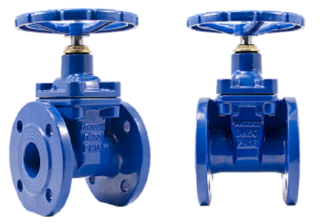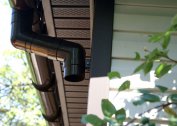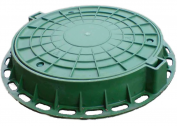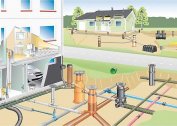To avoid leaks during emergency depressurization of the sewer, it is necessary to install several valves and plugs on the pipe sections. They will contribute to the emergency blocking of wastewater flow.
Definition and purpose
A sewer plug is a plate or sphere that overlaps the internal section of the pipeline.
Latches - reinforcing elements with shut-off valves in the form of a petal, wedge or knife for regulating the internal pressure or completely blocking the flow. They are installed mainly in the arrangement of sewerage on city lines, risers between floors, pressure stations.
Protective and temporary plugs for plastic lines are mounted to block lines that are temporarily not used, inspection hatches. They look like glasses with a smooth surface and are placed in the openings of bends or tees. The output must be equipped with a rubber gasket.
Elements are selected from the material that was used to produce the main pipes - polypropylene and PVC.
Valves with mechanical control are mounted on the connection points of individual lines. On autonomous highways, adjustable gates are mounted in external areas before entering the septic tank.
Complex devices with automatic locking and regulation are equipped with an electric drive and devices for tracking the force of internal pressure. They are used to create the required pressure inside the pressure sewer network.
Installation of locking elements for sewer networks is carried out as planned or urgently to completely or partially block the branch or stop the movement of solid fractions.
Valve classification
According to the type of fixture, the stop valves are divided into the following types:
- gate valves with flange joint;
- caps for rubber gaskets;
- threaded parts;
- welded caps.
The latter are used to permanently block metal pipelines.
In addition to the locking elements mounted outside the sewer pipes, mesh filters are used that pass water and stop the movement of solid waste through the pipeline. To disconnect a separate riser from the common sewer line, pneumatic plugs are installed.
As a valve for external and internal sewerage on a plastic pipe, the installation of membrane type check valves made of polymers is often used. They can be located horizontally or vertically. A locking element is a membrane with a rubber gasket, access for maintenance is provided through the inspection hatch.
Gate valves are used to increase or decrease the throughput of sewer pipes. The difference lies in the complete tightness of the overlap of the internal part of the highway if necessary. For sewage, such a device is preferable, since it can block or restrict the flow of a homogeneous liquid and various substances with solid inclusions or gaseous flows.
A cast-iron or steel sewer gate valve of the slide type is installed on both metal and plastic pipes.
Design Features of Gate Valves
 Gate valves are used to reliably lock the sewers: they are able to hold a lot of pressure. The type of product is determined by the shape of the locking part, and there are two types.In wedge structures, the main locking part, as well as the saddles of the device with wedge-shaped seals. Choosing this type of reinforcement, it is important to consider the diameter of the product - it must coincide with the cross section of the pipe segments.
Gate valves are used to reliably lock the sewers: they are able to hold a lot of pressure. The type of product is determined by the shape of the locking part, and there are two types.In wedge structures, the main locking part, as well as the saddles of the device with wedge-shaped seals. Choosing this type of reinforcement, it is important to consider the diameter of the product - it must coincide with the cross section of the pipe segments.
The advantage of a wedge gate valve is that it can be serviced without particularly complicated actions. The locking block with translational or reverse movement at right angles to the wastewater stream blocks or opens the way for its movement. When the inside of the pipe is completely blocked, the locking wedge is deformed due to the acting load, which increases the tightness. However, wedge fittings cannot withstand intense flows and can fail due to corrosion.
Gate valves with one or two knives are more reliable. They are used in large cross-sections - from 250 mm, steel or cast iron. At enterprises they are equipped with an electric drive or use pneumatic and hydraulic adjustment devices.
Unlike a wedge, a knife-gate has a sharp edge. Sometimes it is performed in the form of a guillotine. Such parts allow you to quickly block the flow of even viscous, containing many foreign inclusions of drains.
There are two types of gate valves for manual control - sliding and non-sliding. The first are devices in which the spindle is fully extended from the pipeline outward to open the duct. Non-retractable devices include a reversible as well as a spherical mechanism.
Criterias of choice
When choosing a locking device, pay attention to the following points:
- method of adjustment and control;
- compliance with the working environment in the highway;
- pipe section;
- Operating conditions;
- brand of the manufacturer.
For example, there are slide gate valves that show excellent efficiency at high temperatures, up to 400 degrees, but can fail in a cold environment.
The cross-section of the gate valves can be different, from 5 to 220 cm, and depends on the application and the diameter of the pipes. The working pressure that such devices can withstand should not exceed 60 atmospheres.
Installation Rules
 The first step in preparing for the installation of the valve is to clean the line. It can be carried out manually (with a brush) or by forcing air, steam or water. Before starting work, check the flanges. They should not contain bends, distortions, scratches, grooves, cracks and other defects.
The first step in preparing for the installation of the valve is to clean the line. It can be carried out manually (with a brush) or by forcing air, steam or water. Before starting work, check the flanges. They should not contain bends, distortions, scratches, grooves, cracks and other defects.
Steps for installing a slide gate valve:
- Checking the distance between the flanges, if necessary, expanding them to a size that exceeds the length of the valves by a centimeter.
- Installation of a valve between the flanges complete with interflange gaskets, fastening of bolts and studs for the coupler.
- Alignment of the locking element between the flanges.
- Accurate removal of devices that were used to extend the flanges and uniform tightening of bolts and studs.
Mount the fittings in a straight section of the sewer line. Avoid the installation of locking elements in places of differences. Stress that can occur on bends negatively affects the tightness of the connection, which can lead to leaks.
If the part needs to be dismantled, first make sure that the knife is in the closed position. After that, unscrew the nuts of the coupling bolts and studs, remove the fasteners, expand the flanges and remove the stop valves.
Sewer pipelines and sewage treatment plants with great “work experience” require reconstruction with the installation of modern shut-off valves. A rational solution is the installation of high-quality gate valves. The presence of locking elements is taken into account when designing new pipelines.




